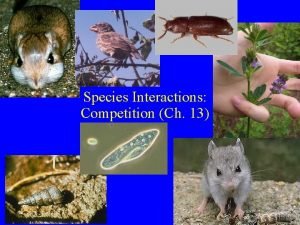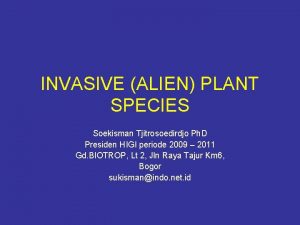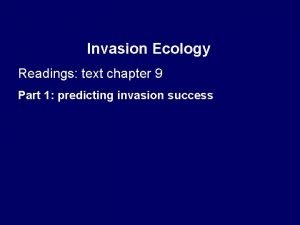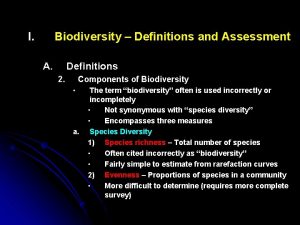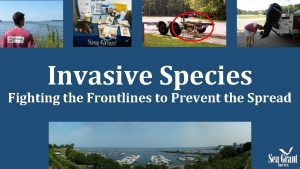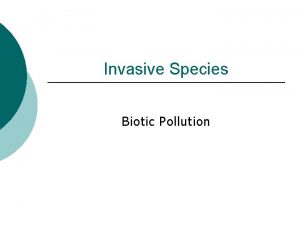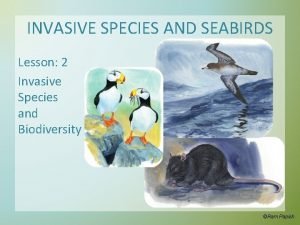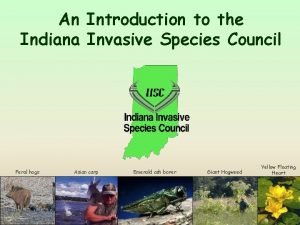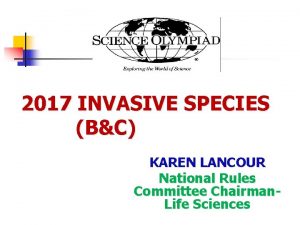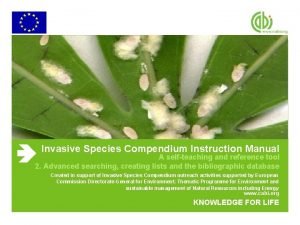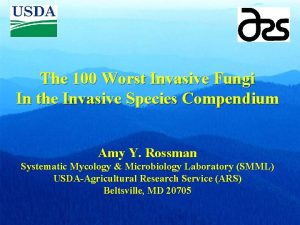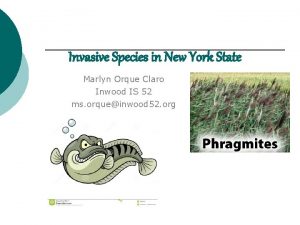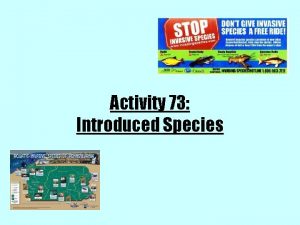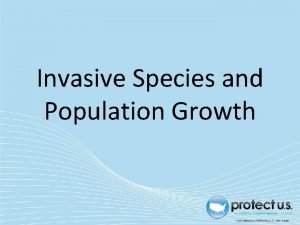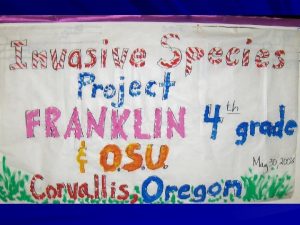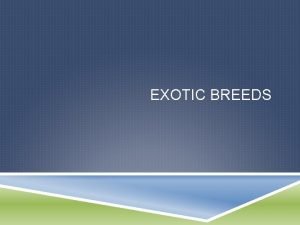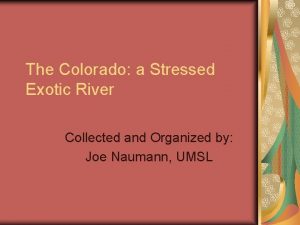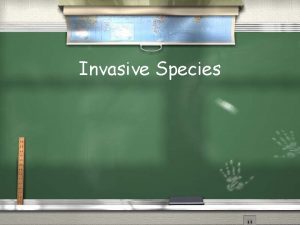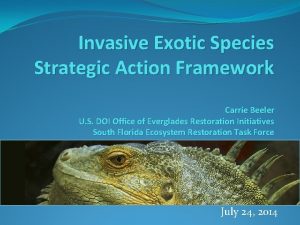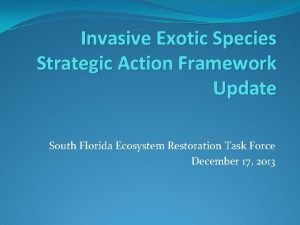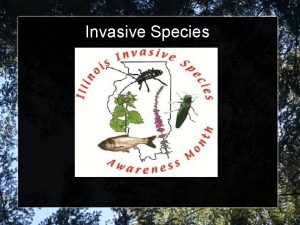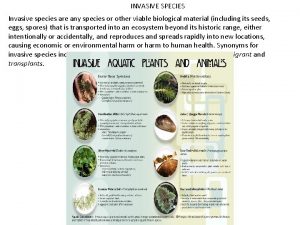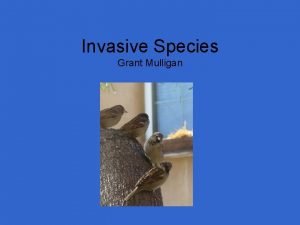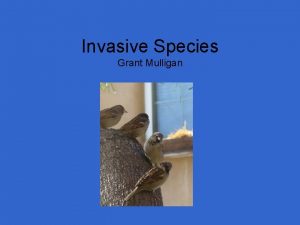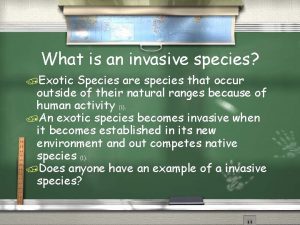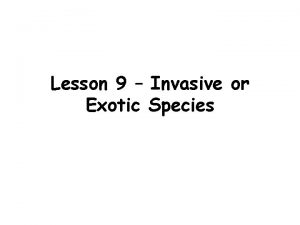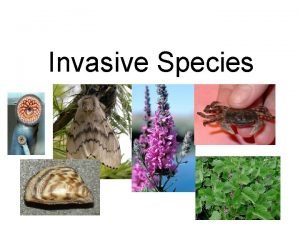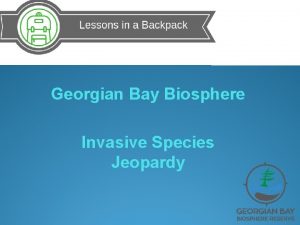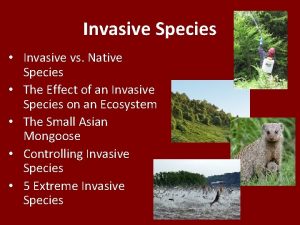Invasive Exotic Species Strategic Action Framework April 2























- Slides: 23

Invasive Exotic Species Strategic Action Framework April 2, 2014

2013 Task Force Direction �July 9, 2013 Task Force Meeting �The Working Group recommended the development of a Comprehensive Invasive Species Strategic Action Framework (2013) that includes a cross cut budget (2010) �OERI to hold a high-level partnership workshop to discuss Strategic Action Framework �Provide coordination support for federal invasive species efforts (2010)

Goals for Today �Update the Working Group and Science Coordination Group on the Strategic Action Framework �Get feedback on the Framework’s: �Structure �Goals �Objectives

Activity to Date �Held 4 IES Strategic Framework meetings �Briefed the WG/SCG (11/19/13) �Briefed the Task Force (12/17/13) �Continuing to broaden the partnership

Current Status �Simultaneously developing: �Printable Framework �Web-based Framework �Suite of case studies �Initiated process to update the Task Force’s overarching Strategy to better address invasive exotic species

Draft Framework Vision, Goals, and Case Studies

Why a Strategic Action Framework? �Help decision-makers understand the connections between goals, strategies, and tactics; �Maximize the extent to which the current capacity for partnership is leveraged to meet common goals; �Help decision-makers make wise and timely investment decisions in the battle against invasive exotics; and �Define success and provide for accountability.

The Stakes Are High �The South Florida Ecosystem, ecologically unique and imperiled by numerous threats, is the subject of the largest ecosystem scale restoration program in the world. �The South Florida Ecosystem is also home to: �a culturally diverse population of almost 8 million residents, including two Indian tribes, �world renowned recreational opportunities, and �strong agricultural and tourism-based economic engines. �Invasive exotic species threaten our environment, economy, culture, and human health. �Combating invasive exotic species is integral to successful ecosystem restoration and the sustainability of south Florida.

Science, Outreach, Coordination, and Funding are Vital �Science forms the foundation for the strategies within every goal area. �Invasive exotic species issues are inherently multidisciplinary. �Success will require interagency cooperation, innovative partnerships, and an informed, involved public. �A successful invasive exotic species program requires long-term commitment of resources.


Goal 1: Prevent the introduction of invasive exotic species.

Goal 1: Prevent introduction of invasive exotic species Preventing introductions of new invasive exotic species is the most cost effective strategy and can yield benefits if invested in upfront and if current barriers are addressed. �Objectives: �Prioritize: Prioritize prevention efforts. �Prevent: Prevent high priority invasive exotic species from entering Tropical Bont Tick �Case Studies: �Heartwater Diseases �Yellow Anaconda �Don’t Pack a Pest Photo: USFWS Law Enforcement

Goal 2: Eradicate invasive exotic species by implementing Early Detection and Rapid Response (EDRR).

Goal 2: Eradicate invasive exotic species by implementing EDRR Successful eradication of newly established invaders through EDRR requires formal collaboration and dedicated staff and funding. �Objectives: bis Sacred I � Prepare & Monitor: Prepare and monitor to enhance early detection. � Assess: Ensure rapid assessment of newly detected species. � Respond: Rapidly respond to identified threats. Gam bia n. P ouc �Case Studies: � Gambian Pouched Rats � Sacred Ibis � Tephritid fruit flies By: Pos kan Kom ent ar h. R at

Goal 3: Contain the spread of invasive exotic species.

Goal 3: Contain the spread of invasive exotic species Consistent resources to address containment, resource protection, and long-term management are needed. �Objectives: �Coordinate: Standardize containment efforts through enhanced coordination. �Contain: Utilize existing control tools to contain invasive exotic species. �Invest: Invest in monitoring, research, science, and tool development. �Assess & Adapt: Determine effectiveness of containment efforts on populations of invasive exotic species.

Goal 3: Contain the spread of invasive exotic species Argentine Black and White Tegu Photo: Dennis Giardina, FWC �Case Studies: �Argentine black and white tegu

Goal 4: Reduce the populations of widely established invasive exotic species and maintain at lowest feasible levels.

Goal 4: Reduce the populations of widely established invasive exotic species and maintain at lowest feasible levels. Consistent resources to address population reduction, resource protection, and long-term management are needed. �Objectives: �Combat: Reduce the population of established invasive exotic species through new controls or increased utilization of existing control tools. �Restore: Reduce impacts of invasive exotic species through restoration of native habitats and species. �Invest: Invest in monitoring, research, science, and tool development. �Assess & Adapt: Determine effectiveness of long-term management efforts on populations of invasive exotic species.

Goal 4: Reduce the populations of widely established invasive exotic species and maintain at lowest feasible levels. �Case Studies: �Shoebutton Ardisia �Ambrosia beetle/laurel wilt disease �Lionfish �Burmese python Lion Fish �Melaleuca By: Reef. o rg Melal euca By: M in B R ayama jhi

Next Steps

Next Steps �Looking for Working Group/Science Coordination Group feedback on the Framework’s structure, goals, and objectives. �Refining the draft with IES partners. �Continuing to enhance web-based framework.

IES Framework Schedule �April 2 – Progress update presented to the Working Group/Science Coordination Group �April 9 – IES Frameworking meeting �May 5/6 – Progress update presented to the Task Force
 Exotic species definition
Exotic species definition Exotic species definition
Exotic species definition Exotic species definition
Exotic species definition Exotic species definition
Exotic species definition Exotic species definition
Exotic species definition Exotic species definition
Exotic species definition Characteristics of invasive species
Characteristics of invasive species Invasive species characteristics
Invasive species characteristics Invasive species characteristics
Invasive species characteristics Indiana invasive species council
Indiana invasive species council Invasive species characteristics
Invasive species characteristics Invasive species compendium
Invasive species compendium 100 worst invasive species
100 worst invasive species Invasive species investigator worksheet
Invasive species investigator worksheet Invasive species investigator worksheet
Invasive species investigator worksheet Invasive species growth curve
Invasive species growth curve Are invasive species always bad
Are invasive species always bad Invasive species act ontario
Invasive species act ontario Can plants be keystone species
Can plants be keystone species Nuclear pasta
Nuclear pasta Exotic breeds of rabbit
Exotic breeds of rabbit Exotic beam summer school
Exotic beam summer school Woman walking in an exotic forest
Woman walking in an exotic forest Is the colorado river an exotic stream
Is the colorado river an exotic stream

